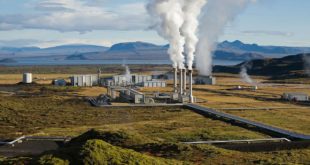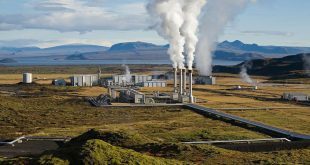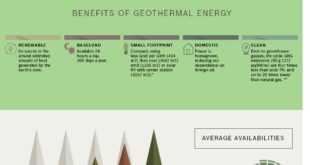
Nearly 300 industry leaders gathered in Reno last week for the Geothermal Energy Association (GEA) National Geothermal Summit. The leading forum for Western State policy discussions, the National Geothermal Summit brought together the industry for a dialogue with state and federal policy makers. The industry met to discuss such issues as moving geothermal forward in Nevada; utility perspective on renewable portfolio standards and geothermal; the future of the renewable portfolio standard (RPS); tax incentive perspectives; achieving the potential of the Salton Sea and Salton Sea Restoration Initiative; protecting the existing industry base; and regulatory matters including leasing, permitting, and sage grouse habitat considerations.
Notable speakers provided keynote addresses throughout the agenda, including: Senator Kelvin Atkinson, Nevada Senate District 4; Assemblyman David Bobzien, Nevada Assembly 21; Rebecca Wagner, Commissioner, Public Utilities Commission of Nevada; Karen Edson, Vice President, Policy and Client Services, California ISO; Rob Oglesby, Executive Director, California Energy Commission; and Doug Hollett, Program Director, U.S. Department of Energy Geothermal Technologies Office. Senators Harry Reid and Dean Heller provided Video Greetings. Industry leaders participated in a press conference on the day of the event to point out the status and issues of geothermal development today. For audio of the press conference, please click here.
“Geothermal is a viable, affordable technology with large amounts of untapped resource, and we can provide clean energy to the West as well as jobs and economic growth,” said GEA Executive Director Karl Gawell. “Despite uncertainties in geothermal policies we’re still seeing a growing and innovating industry, but the next five years will be critical.”
The industry expressed concern over policy uncertainties, which continue to create barriers to growth, while calling for stable policies that will foster the developing technology. Besides extending tax credits, many leaders agreed that not much can be expected at a federal level. Instead, the focus was on states as the drivers for growth, with sustained growth expected in Nevada and California, and new projects in development in Utah, Oregon and Washington, among others.
Ormat Technologies was the Summit co-host. Bob Sullivan, Vice President of Business Development, Ormat Technologies, said the U.S. is in “a period of significant change in the electrical grid.” Sullivan called the technology a “flexibility procurement” and said it is “one of geothermal’s hidden attributes.” Geothermal’s flexible dispatchability addresses a growing intermittence issue, he said.
In the past, Sullivan said, geothermal has been “pigeon-holed” under Renewable Energy Certificates (RECs), “but it can be so much more than that,” he said. “It has all the attributes of a coal facility, the backbone of our electrical grid that we count on it day in and day out. Coal is being replaced with intermittents that you can’t count on, that need backup power. Geothermal provides inertia and voltage regulation, and also provides the green attributes.”
Sullivan continued: “On top of that it’s a real economic job engine. Our investment significantly positively impacts the local communities that we build in, so it has a big economic footprint, and it creates more jobs than any other renewable technology out there. As a baseload technology, geothermal can back up intermittent resources with no carbon footprint at all.”
Paul Thomsen, Director at the State of Nevada Governor’s Office of Energy, said that while other states that have a renewable portfolio standard (RPS) are trying to determine how to meet their goals, Nevada has already met its RPS requirements ahead of schedule and with a geothermal-strong portfolio. The state has not stopped planning for additional renewable capacity, including additional geothermal, and its renewables approach with friendly policies and strong grid support recently won the state an Apple data center contract. “We’re participating in this conference to see what Nevada can do to continue to be a national leader in geothermal development,” Thomsen said.
Terry Page, Director of Regulatory Affairs Innovation, Enel Green Power noted there is renewed interest in California for geothermal technology as the state recognizes some of the shortfalls of bringing on too much intermittent solar and wind power. “The Geothermal Energy Association is an international organization, and there’s a lot of activity particularly in Africa and other nations. But we’re beginning to see renewed interest in geothermal in California because of SB 1139, and Nevada because of SB 123. Both of those bills have generated a debate about what kind of renewables we need. For example, in California with the wind and solar resources, there’s a significant shortfall when the sun doesn’t shine and the wind doesn’t blow. The kind of projects Enel focuses on tend to mitigate that [through hybrid technologies],” Page noted.
Carl Stills, Energy Manager, Imperial Irrigation District discussed the District’s current policy initiative that calls for geothermal development as an economic aid in its plan for restoring the receding Salton Sea. “Geothermal will be the perfect vehicle to help at the Salton Sea, and also meets AB-32,” Stills said.
Scott Nichols, US Geothermal, who also represented the company in July congressional hearings, said it is equally important to focus on streamlining issues of permitting and access to adjacent lands as it is focusing on on-the-ground implementation and administrative work. “Geothermal’s [environmental] footprint is miniscule compared to other technologies. The attributes that geothermal provides really need to be promoted. We don’t have a huge footprint, we don’t have adverse visual concerns that other technologies see.”
Doug Hollett, Program Director, U.S. Department of Energy Geothermal Technologies Office said the agency seeks to advance the technologies and drive down the cost of developing attractive geothermal resources. “We’re seeing greater market awareness and increased exploration activities,” Hollett said. “Our feeling is that trend will continue. We’ve got a lot of geothermal out there that we sometimes forget to mention, Alaska, Hawaii. In some places it ends up offsetting diesel, which is just a wonderful story.”
The industry will reconvene for the world’s largest gathering of geothermal professionals at the GEA Geothermal Energy Expo 2014 in Portland, Oregon, from Sept. 28 through Oct. 1. For more information, visit http://www.geo-energy.org/new_expo/default.asp.
 Alternative Energy HQ solar power for homes, wind energy, and bio fuel issues
Alternative Energy HQ solar power for homes, wind energy, and bio fuel issues





